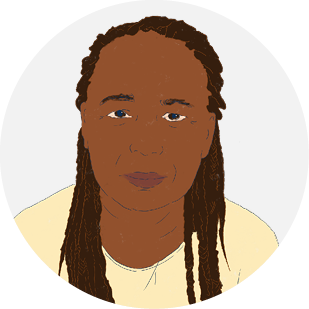I will work until they throw dirt in my face if I'm capable.
Where we are
Many older people in the United States struggle to understand when or if they can retire. Difficult decisions and sometimes overwhelming complexities accessing retirement programs make for a stressful transition.
Nearly nine out of ten people aged 65 and older receive Social Security retirement benefits, and Medicare covers nearly 64 million people1. Yet—irrespective of income, education level, and race—navigating the process to claim retirement benefits and enroll in Medicare can be time-consuming, confusing, and complex for new enrollees. For example, people may have to share the same information with several government agencies, while navigating differing age-based eligibility thresholds. If the process feels too overwhelming, individuals may miss out on critical supports for which they are eligible, including financial, housing, and nutrition.

Our approach
To start, we listened to people’s stories.
The Life Experience research team spoke with people nationwide about this moment in their lives and where the government process could have been simpler and more helpful. The listening sessions captured honest conversations about peoples' experiences, candid feedback on what could have worked better, and what really made a difference for them. Their stories have been combined and are represented here through illustrations. The quotes are real, but names have been changed.












Throughout the three-month discovery, the team collaborated across four agencies to perform primary and secondary research analysis around the approaching retirement experience. Of the 42 seniors who participated in listening sessions, diverse representation included 14 couples, 25 women, 18 persons of color, 7 widowed, and 7 high school educated.
The team spoke with:
- 42 seniors
- 40 Medicare and Social Security experts
Discovery insights
Framing for collective thinking about customer pain points
How might we improve access to tools and knowledge that help remove barriers to financially preparing for retirement?
How might we ease the transition to retirement by streamlining the user experience and better connecting people to accurate support to aid their decision making?
How might we provide equitable access to available resources to help seniors recover from employment setbacks and to increase financial security by ensuring individuals understand the benefits and programs available to them?Design Phase
Designing customer-centered solutions
View progress on our milestonesIn the 2024 design phase, the portfolio is running three projects:
- Increasing access to decision-making support for older adults aims to update the Federal Resource Guide and implement a community of practice for local community-based organizations.
- Streamlining Medicare-only enrollment will resume work on this project after a pause in 2023.
- Linking senior benefits programs between HUD and SSA, a new project designated in 2024, aims to pilot customer data-sharing between the Social Security Administration (SSA) and the Department of Housing and Urban Development (HUD) during HUD applications, to the extent allowable, to help jumpstart housing assistance for seniors eligible for support.
The project aims to facilitate a community stakeholder-centered design process to build and test an information and outreach model to help older adults make informed retirement and healthcare decisions through connections to trusted community-based resources.
The pilot stage will include publishing a new Federal Resource Guide and distributing it through six community-based organizations and their clients. The pilot stage will also include the implementation of a Community of Practice. Both activities will include implementation and outcome evaluation activities.
Project objectives
Increase the accessibility and availability of holistic resources at existing touchpoints (such as community-based organizations); raise awareness about local resources; and reduce the burden on older adults as they are making retirement and healthcare decisions. As a result, individuals will more easily determine the correct steps for their personal situations.
Updates
The Administration for Community Living (ACL) at the Department of Health and Human Services led a pilot of two concepts: the Federal Decision Support Guide, and the Federal Forum on Serving Older Adults.
The Federal Decision Support Guide was translated into Spanish and Chinese, and lives on ACL’s Approaching Retirement Age website. The guide was created in collaboration with community-based organizations (CBOs), and then piloted with six community-based organizations (CBOs) that work directly with older adults. During the pilot, these CBOs used the guide with clients in counseling sessions. In surveys of older adults who interacted with the guide, a majority agreed that the guide reduced their level of worry about the financial and healthcare decisions they needed to make, and made the process of obtaining benefits easier to understand.
ACL also hosted three Federal Forums with presentations by Federal agency partners, and over 380 participants. After the June Forum, most respondents agreed that the Forum increased their access to materials that will assist them in helping older adults make informed financial and healthcare decisions, and a majority agreed that their participation increased their understanding of Federal programs, increased their access to materials and tools, and will reduce the time it takes to navigate Federal resources.
In the next phase of the project, ACL plans to develop an interactive website to improve accessibility of the guide resources and continue to pilot the existing materials and the redesigned website with additional CBOs.
See the 2024 project evaluation plan to learn about the project measures and methods.
The team led the project through a complete design phase, which included designing two concepts to support older adults, their caregivers, and frontline staff: a Federal Decision Support Guide and a Federal Forum on Serving Older Adults. The team developed the concepts from sketches to prototypes throughout nine co-design sessions with national and community-based organizations and 11 cross-agency workshops. The prototypes create a foundation for agencies to transcend separate functions or departments and collaborate in new ways, which should lead to more systemic and customer-centered interventions.
- The Federal Decision Support Guide consolidates information on resources and benefits from seven agencies to help older adults, caregivers, and frontline staff make informed decisions about healthcare, finances, housing, and nutrition. It consists of modules including Federal benefits and services available, rules and considerations for eligibility, how and where to apply, and where to turn for personalized assistance. The project team developed the content collaboratively with input from HHS (both ACL and CMS), CFPB, HUD, SSA, and USDA. The team completed usability testing with six frontline staff and six members of the public.
- The Federal Forum on Serving Older Adults is a community of staff who support older adults to connect with Federal staff who work in senior-focused programs. It will center around learning through engagement, with topics that strengthen Federal understanding of how programs can better connect to on-the-ground needs, and will focus solutions on specific outreach challenges or communities that are hard to reach. The project team created a prototype of the Federal Forum and tested it through a desirability survey.
In FY 2024, the Administration for Community Living (ACL) at HHS will lead the pilot phase for both concepts. ACL will launch digital and translated versions of the resource guide and pilot its use with select community-based-organizations. Additionally, ACL will pilot a year of quarterly Community of Practice sessions, hosted collaboratively by Federal agency partners across Government.
Measures of success
Key outcomes:
The project’s success is defined by its ability to reduce customer navigation burden and duplicative processes, connect older adults to streamlined information available across a variety of Federal agencies and programs, and improve the ability of older adults to make informed choices that work for them.
Design phase project measures:
The project aims to improve the customer experience for individuals who are 65 and eligible for Medicare but are not yet receiving Social Security Retirement benefits.
The design work may include exploratory research about: better equipping customers for enrollment decisions through direct outreach; consolidating customer touchpoints during enrollment; using Health and Human Services (HHS) regulatory authority to prevent unintentional lifelong penalties; making the Social Security Administration (SSA) digital identity verification experience accessible for all; processing Medicare claims in a fully automated, configuration-driven fashion by default; and making it effortless for customers to receive their Medicare Beneficiary Identifier.
Project objectives
Enhance the customer experience by improving Medicare content and information on SSA.gov and Medicare.gov; develop improvements to modernize and streamline the Medicare-only application process.
Updates
In 2024, the Social Security Administration (SSA) and the Centers for Medicare & Medicaid Services (CMS) enhanced the customer experience for individuals aged 65 who are eligible for Medicare but not yet receiving Social Security Retirement benefits:
- SSA added a button to the Medicare application confirmation screen on SSA.gov, leading users to a new landing page and driving roughly 20,000 new enrollees to the Medicare Getting Started page each month.
- SSA and CMS together updated CMS’s Application for Enrollment in Medicare Form to obtain more information at the first point of contact and remove the need for a wet signature.
- CMS’s Office of Communications updated web content to encourage millions of people who receive a Medicare premium bill to pay their Medicare premiums online.
- CMS updated notices and handbooks that are sent to tens of millions of people annually to refer users to appropriate SSA.gov webpages instead of SSA’s 1-800 Number wherever possible, improving the customer experience of calling SSA’s 1-800 Number with questions about Medicare that SSA 1-800 Number agents are unable to address.
These changes reflect SSA and CMS’s commitment to simplifying processes, reducing administrative burdens, and improving the overall experience for Medicare beneficiaries.
In early 2023, the team conducted an extended scoping effort to identify near-term and longer-term improvements that could enhance the customer experience enrolling in Medicare-only at age 65. The team began by improving content and page design on SSA.gov and Medicare.gov. They also explored options for more process design improvements as individuals navigate the two websites and enrollment steps.
The team completed secondary research to understand when and how customers enroll in Medicare and the pain points that some people experience. The team conducted stakeholder interviews with staff from SSA operations and CMS Medicare.gov; they also shadowed telephone appointments for customers enrolling in Medicare through SSA. The team also reviewed existing reports that address improving customer experiences.
After this extended scoping phase, the team paused the effort for now due to SSA’s concerns with its resources and capacity to continue the work in the near term. The team’s work to date—including on customer insights, potential solutions to modernize and streamline the Medicare-only application process, and the in-depth confirmatory research needed to support those solutions—will inform future efforts. Additional information is provided below.
Key outcomes:
This project aims to see a measurable reduction in the time spent between customers’ decision to begin the Medicare enrollment process and when the coverage begins. Project success depends on its ability to reduce customer navigation burden, minimize duplication, and effectively communicate the steps to enroll in Medicare.
Measures of success
The project aims to enable real-time customer data-sharing between the Social Security Administration (SSA) and the Department of Housing and Urban Development (HUD) during HUD applications, to the extent allowable, to help jumpstart housing assistance for seniors eligible for support.
The design work will include designing a pilot project focused on streamlining income verification for fixed-income HUD tenants and applicants.
Project objectives
Improve financial and housing stability for older adults, simplifying income verification for seniors applying for or renewing housing assistance. As a result, HUD and SSA staff will spend less time providing income information to SSA recipients on a case-by-case basis.
Updates
Modernizing the Enterprise Income Verification (EIV) system aims to improve HUD’s data exchanges with SSA and other Federal partners. The project improvement aims for Public Housing Agencies (PHAs) to be able to validate Social Security income in real-time rather than quarterly (the current state) to determine tenant eligibility. By increasing the frequency of data exchanges with SSA, HUD seeks to streamline processes, reduce improper payments to PHAs, and minimize the need for tenants to visit SSA field offices.
HUD received funds to modernize the EIV system in the 2023 Budget, and the IT modernization performance plan that covered these activities was approved in 2024. HUD continues coordinating with the agency’s IT modernization strategy and SSA to enhance EIV and improve customer experience.
Key outcomes:
Improve financial and housing stability for older adults, simplifying income verification for seniors applying for or renewing housing assistance. As a result, HUD and SSA staff will spend less time providing income information to SSA recipients on a case-by-case basis.
Measures of success
Project Documentation
- Portfolio Charter
- Portfolio Summary
- Design Project Summary: Increasing Access to Decision-Making Support for Older Adults
- Design Project Summary: Streamlining Medicare-Only Enrollment
- Design Project Summary: Linking senior benefits programs between HUD and SSA
- Customer Journey Map & Stories
- Information collection approved under OMB Control #3206-0276
- Life Experience Initiative Summary
- Executive Order 14058
- President’s Management Agenda
Project Outputs
- Federal Decision Support Guide
- Evaluation Plan (v.1): Increasing Access to Decision-Making Support for Older Adults
- Evaluation Plan (Summary): Increasing Access to Decision-Making Support for Older Adults
- Streamlining Medicare-Only Enrollment, Design Phase I Findings Summary
Agency collaborators
- General Services Administration (GSA)
- Department of Labor (DOL)
- Department of Housing and Urban Development (HUD)
- Department of Agriculture (USDA)
- Office of Management and Budget (OMB)
- Department of Health & Human Services (HHS)
- U.S. Department of the Treasury (Treasury)
- Social Security Administration (SSA)
- Consumer Finance Protection Bureau (CFPB)
